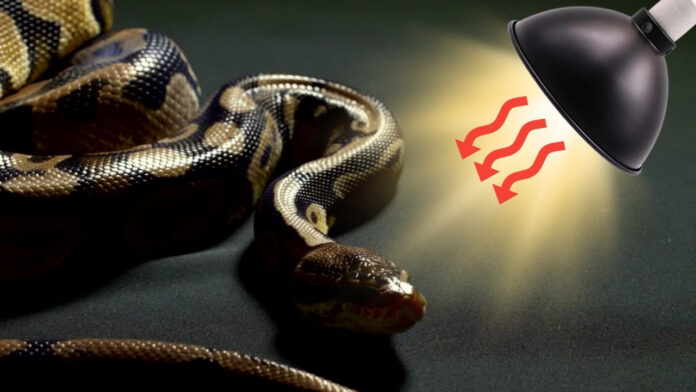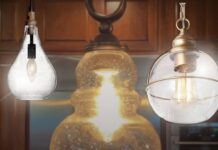Ball pythons make great pets for a number of reasons, not the least of which is their adaptability. One thing you’ll want to take into account when keeping a ball python is their environmental needs, in particular, providing them with an adequate heat source.
In this post, we’ll discuss the top 5 Best Heat Lamp For Ball Python and provide some tips on how to choose the right one for your pet. So read on to learn more!
| Image | Title | Buy |
|---|---|---|
 | Fluker's Ceramic Heat Emitter for Reptiles Black, 100 Watts | Buy on Amazon |
Top | Zacro Reptile Heat Lamp 100W with One Digital Thermometer, Infrared Ceramic Heating Non-light Lamps Emitter 110V (Black) | Buy on Amazon |
 | Ceramic Heat Emitter, Ceramic Heat Lamp Bulb, Infrared Reptile Heat Emitter Heater Lamp Bulb for Turtle Snake Chicken (250) | Buy on Amazon |
 | Fluker's Sun Dome Reptile Lamp - Deep Dome Fixture, black, 8.5-inches (27003) | Buy on Amazon |
 | Reptile Heat Lamp Bulb - 100W Ceramic Heat Emitter No Harm No Light Infrared Heater Lamp for Chicken Coop Lizard Aquarium Snake Outside Dogs Brooder 110V | Buy on Amazon |
1. Fluker’s Ceramic Heat Emitter for Reptiles:
- 100 watt ceramic heat emitter for reptile habitats
- Heat emitters radiate intense infrared heat but emit no light
- The perfect 24-hour heat source for your tropical or desert reptile
- If the environmental temperature in your terrarium is inadequate, your pet reptile may be susceptible to digestive problems or infecti
If you’re looking for an affordable and reliable heat lamp for your ball python, Fluker’s Ceramic Heat Emitter is a great option. This ceramic heat emitter produces no light, making it ideal for basking spotlighting. It also doesn’t produce any harmful UVB rays, so you can feel confident that your pet is safe.
The Fluker’s Ceramic Heat Emitter comes in a variety of wattages, so you can choose the right one for your needs. Fluker’s Ceramic Heat Emitter is a versatile and affordable option for providing 24-hour heat to your reptile habitat.
This ceramic heat emitter emits intense infrared heat, but no light, making it the perfect choice for establishing an appropriate temperature range in your terrarium.
If the environmental temperature in your reptile enclosure is inadequate, your pet reptile may be susceptible to digestive problems or infections. 100-watt ceramic heat emitter for reptile habitats.
2. Zacro Reptile Heat Lamp 60W / 100W / 150W:
- Perfect 24 hour heat source for all types of reptiles.
- 99% high thermal efficiency.
- Solid ceramics element has a good heat radiation feature.
- Flat-faced design.
The Zacro reptile heat lamp has a ceramic element that makes it 99% efficient in heating. It also comes with a digital thermometer to help you monitor the temperature of your pet’s habitat. The flat-faced design of the Zacro heat lamp is more efficient and longer-lasting than the conical design.
Which can build up excess heat. It is available in three different wattages (60W, 100W, and 150W) to accommodate different size habitats. This Zacro reptile heat lamp has an adjustable temperature range of 60-100 degrees Fahrenheit, making it ideal for a variety of reptiles and amphibians.
The lamp also comes with a digital thermometer, so you can keep track of the temperature in your terrarium. This heat lamp is made with infrared ceramic heating elements, which emit no light and are safe for your reptile’s eyes.
The Zacro reptile heat lamp is a great choice for those who want to provide their reptiles with a warm, comfortable environment. Match the ceramic E27 socket only because the plastic E27 socket may melt the lamp holder and even cause the lamp explosion.
3.The Blue Stone 50W 100W 250W Ceramic:
- Solid ceramics element.
- Lamp is simple and easy to install.
- This non-light emitting heater bulb offers an excellent 24 hours heat source.
- Voltage: AC 110-120V; Power: 250w; Material: Ceramic, Metal, NiCrAl
The BlueStone ceramic heat emitter is a no-light infrared reptile heat lamp that is ideal for use with ball pythons. It produces no light, so it won’t disturb your snake’s sleep cycle, and it emits a steady, even heat that will keep your python warm and comfortable.
This heat lamp is available in three different wattages (50W, 100W, and 250W) so you can choose the one that best suits your needs. It comes with a mounting bracket and hardware for easy installation, and it comes with a one-year warranty.
The Blue Stone ceramic heat emitter is a less light-emitting heat source perfect for all day and night use. It has an infrared output that is beneficial to reptiles and can be used in wet environments. The dimensions of the heating surface are 12.5 cm/5″ ( approximate) in diameter and 10.8 cm/4.3″ (approximate) in height. It has a standard E26 120-volt American base.
4. Fluker’s Sun Dome Reptile Lamp – Deep Dome Fixture:
- The polished aluminum surface inside the dome increases UVB and UVA output to domes with interior white surfaces
- Deep Dome Clamp Lamp is specifically designed to accomodate larger or longer bulbs.
- Dome diameter 8.5
- 160 watt
Fluker’s Sun Dome Reptile Lamp is the best heat lamp for ball pythons. It has a deep dome design that allows for more directed light and heat, and it also comes with a ceramic socket and a safety guard.
This lamp is ideal for creating a warm basking spot for your ball python, and it will also help to keep their enclosure warm and comfortable. Fluker’s Sun Dome Reptile Lamp – Deep Dome Fixture is specifically designed to accommodate larger or longer bulbs, such as our Fluker’s Sun-Glow and Sun Spot bulbs.
The polished aluminum surface inside the dome increases UVB and UVA output to domes with interior white surfaces. The dome has a diameter of 8.5 inches and can accommodate bulbs up to 160 watts.
5. Reptile Heat Lamp Bulb – 100W Ceramic Heat Emitter:
- Suitable for High Humid Environments.
- High Heat Efficiency.
- No Light Emitter.
- Long Lifespan.
This heat lamp bulb is ceramic, so it gives off infrared heat. It is 100 watts and comes in white color. The benefit of this heat lamp is that it does not produce any light, so it will not disturb your ball python’s sleep cycle. This heat lamp can be used for reptiles, chickens, dogs, and other animals.
This 100W black infrared heat lamp is made of high-purity pottery clay, which is resistant to high temperatures, ensuring its crack resistance. It can work in high humidity terrariums. The reptile heat lamp uses a spiral surface design that lengthens the length of the filament, enlarging the heating area and increasing the space temperature in a short time, and achieving 100% heating efficiency.
The ceramic heat emitter offers an excellent 24 hours heat source, perfect for lizards, snakes, and tortoises growing, lasting up to 10000 hours, even longer. Note – Do not touch the heat lamp immediately after turning it off, please wait at least 1 hour to cool down. Also please adjust the distance between the heat lamp and the pets.
Things You Should Consider When Buying Best Heat Lamp For Ball Python.
There are a few factors you’ll need to consider when purchasing the best heat lamp for your ball python.
1. Lightning:
However, it is best practice to keep a light on to mimic nature’s day/night cycle. Because of their equatorial origin, ReptiFiles recommends a day/night cycle of 12 hours on, and 12 hours off. If you want to get more specific with your light cycle, you can leave the lights on for 12.5 hours during summer and 11.75 hours during winter (using a low-strength UVB fluorescent as your light source).
You need to create a basking area for your python where it can warm itself under the heat lamp. Make sure to buy a lamp that emits enough light to provide the right temperature gradient in your terrarium.
Although UVB is invisible to the human eye, it’s an important and necessary part of a snake’s environment. Without it, they can experience physical and mental health problems. By following these simple guidelines, you can provide your ball python with the UVB they need to stay healthy.
2. Temperature:
If you are a ball python keeper, it is important to be aware of the environmental conditions in which your snake lives. You can create an artificial environment that replicates their natural habitat as closely as possible, but it is also important to have a basic understanding of the climate zone your snake comes from.
The ideal basking temperature for a ball python is between 88 and 92 degrees Fahrenheit (31-33 degrees Celsius). The cool side of the enclosure should be between 78 and 80 degrees Fahrenheit (26-27 degrees Celsius).
3. Weather Proof:
If you live in an area with a lot of extreme weather conditions, it’s important to buy a heat lamp that can withstand those conditions. If you live in a place that gets very hot, make sure the heat lamp you choose can take the heat. Some heat lamps are designed to be used in extreme conditions, so make sure to do your research before making a purchase.
4. Safety:
When choosing a heat lamp for your ball python, it’s important to consider safety. Make sure the heat lamp you choose is made with non-toxic materials and that it is UL (Underwriters Laboratories) certified.
5. Durability:
You want to make sure the heat lamp you choose is durable and will last a long time. Some heat lamps are made with glass or ceramic, which can break easily. Others are made with metal, which is more durable. Choose a heat lamp that will be able to withstand the wear and tear of your ball python’s habitat.
6. Size:
When choosing an enclosure for your ball python, size is an important factor to consider. A general rule of thumb is that the enclosure should be twice as long as the snake and one-and-a-half times as wide. So, if you have a baby python that is 12 inches long, the enclosure should be 24 inches long and 18 inches wide.
As your python grows, you will need to upgrade to a larger enclosure. A good way to determine if your snake has outgrown its enclosure is to see if it can comfortably stretch out from one end of the enclosure to the other. If it can’t, then it’s time for an upgrade.
7. Power Type:
There are two types of power sources for heat lamps: electric and battery-operated. Electric heat lamps are the most common type, but they require an outlet to work. Battery-operated heat lamps are convenient because they can be used anywhere, but they can be more expensive.
8. Ease of Use:
When choosing a heat lamp, it’s important to consider ease of use. Some heat lamps are easier to install than others. Make sure to read the instructions carefully before making a purchase.
9. Price:
Heat lamps can range in price from $20 to $100. The price will depend on the brand, the features, and the size of the heat lamp. If you are on a budget, there are some good-quality heat lamps available for less than $50.
10. Warranty:
When purchasing a heat lamp, it’s important to check the warranty. Some companies offer a one-year warranty, while others offer a more comprehensive warranty. Choose a heat lamp that comes with a warranty that meets your needs.
Conclusion:
The best heat lamp for a ball python is the one that will provide the right level of warmth and humidity. There are many different types of lamps on the market, so it is important to do your research before making a purchase.
By considering the size of your snake, the type of bulb, and where you will be placing the lamp, you can find the perfect fit for your pet. We hope this article has been helpful in guiding you to make an informed decision about the top 5 best heat lamps for a ball python.
FAQs:
1. What heat bulb does a ball python need?
Answer: A ball python needs a heat lamp. The wattage of the lamp will depend on the size of your snake. For example, a 40-watt bulb is usually sufficient for a small snake, while a 100-watt bulb is needed for a larger one. When deciding on what bulb to buy, be sure to look for incandescent or ceramic light, as these give off the most heat.
2. Do snakes need a heat lamp 24 7?
Answer: No, snakes do not need a heat lamp 24/7. In fact, most snakes only need a heat lamp for a few hours a day – typically around 12 hours. The rest of the time, they can be kept at room temperature. There are some exceptions though, so it’s always best to check with a reptile expert before setting up your snake’s habitat.
3. Is a heating pad enough for a ball python?
Answer: For a ball python, a heating pad is usually enough. However, depending on the size of your enclosure and the wattage of your heat pad, you may also need a lamp. If so, make sure the light is far enough away from your snake that it can’t get burned.
4. Do ball pythons need UV light?
Answer: No, ball pythons do not need UV light. There is some debate on whether or not reptile tanks should have a basking spot with a UVB bulb, but the general consensus seems to be that it is unnecessary. Your ball python will do just fine without one!









